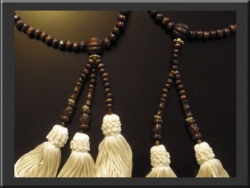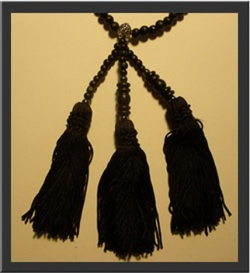Tassels - They're not just for priests
by David Heimburg
If you currently belong to a Nichiren Buddhist organization other than NBAA, you will be "discouraged" from using meditation beads with tassels. Instead, you will be asked to buy beads with ridiculous looking little pom-poms.
Those other Nichiren Buddhist organizations currently say that only priests are "allowed" to use beads with tassels (or pom-poms with extended tassels) because this denotes their "status as teachers of the Law and to share their benefit."
They further explain that the balls or pom-poms that all people other than priests must use symbolize the spread of Buddhism world-wide (aka kosen rufu).
The idea, I suppose, is that the pom-poms extend their ends in every direction from the center, and this indicates spreading Buddhism.
Nice thought, until you consider what "center" they're alluding to.
Presumably it's the sangha, which specifically means the group of monks and nuns who renounced secular life and dedicated themselves to Buddhist practice night and day but more generally includes all Buddhist practitioners: monks, nuns, laymen, and laywomen; collectively, the grouping of all Buddhist practitioners.
If, in fact, that is what the pom-poms mean then why don't they mean the same thing for priests who should be part of this sangha?
What they're really saying by enforcing the use of only pom-poms for non-priests, is that priests are really special and should be treated with more respect than you deserve.
Both Buddhists (laity & priests) should have the same kind of Buddhist practice, according to Nichiren.
He advocated that there should "be no distinction" between those who practice Buddhism, presumably referring to the thought that there should be no distinctions of the status of each person rather than differences in the personal mission of each.
Priests perform ceremonies such as weddings and funerals. Laity do not (usually).
Laity have more opportunity to talk with others about Buddhism than priests do, and typically are more effective at teaching Buddhism broadly within society.
There is a current point of view among some other Buddhist organizations that Buddhism is best propagated by keeping the roles of laity and priests distinct and separate. We of NBAA feel that while certainly there will be different personal areas of emphases for as many individuals, whether they be priests or laity, as there are, those who practice Buddhism are not really different from each other at all in terms of function and purpose.
Then there are people who choose not to directly teach Buddhism to others but will instead invite friends to attend meetings or attend their temple to hear a priest.
There are still others who just financially support the priesthood and in this way consider their offerings as their practice for the accomplishment of kosen rufu or world wide propagation of Buddhism.
There may be circumstances that people find themselves in which make these methods the most viable and appropriate for them. Some examples might be that you're living in a country in which you don't speak the native language fluently yet.
Or you may have certain physical or mental illness that limits your opportunity to engage with others socially and you therefore have few opportunities to teach Buddhism.
By using priests or others' ability to teach Buddhism on your behalf, you can still participate in the spread of Buddhism using these indirect methods.
But if you are capable of teaching Buddhism to others you should definitely do so.
Teaching Buddhism becomes your arena for developing your compassion, your Buddhahood.
The more you teach, and the more sincerely you teach, the more you, in the process, will learn about Buddhism and about your own path to the development of Buddhahood.
Certainly it all starts with your own practice of Buddhism. But almost immediately your practice can include your own sincere efforts to teach and encourage others as well.
There's a quote from the Lotus Sutra, "Teacher of the Law" (tenth) chapter, that says: "… [O]ne who secretly teaches to another even a single phrase of the sutra should be regarded as the Buddha's envoy, sent to carry out his work."
Nichiren teaches that "a single phrase" can mean Namu-Myoho-Renge-Kyo.
That phrase is not only the title of the Lotus Sutra, it's also the essence and meaning of the entire Lotus Sutra.
So teaching someone to chant Namu-Myoho-Renge-Kyo is teaching Buddhism.
The term envoy in the quote above, refers to a person who acts as an agent for another.
This signifies that teachers are envoys of their own and others' Buddha nature and that their own Buddha nature is revealed and brought out in the act of compassionately teaching another person about Buddhism.
You're acting as an envoy of your own Buddha within. So being a teacher of the law is not outside the grasp of everyone.
So for NBAA members, each has taken vows to devote their entire lives to the practice and study of Buddhism. In this regard they are no different from priests (and some in fact are priests).
They accomplish the task of fulfilling their vows while remaining within society. That is, they hold jobs, raise families, and otherwise carry on normal lives.
There are various bead makers and vendors who sell both beads with tassels and beads with pom-poms.
NBAA is the only Buddhist organization today that encourages its members to use only the tassel beads. But anyone, regardless of organizational affiliation should consider using tassel beads.
And they should consider taking vows as well. In this way we hope to encourage more and more individuals to become teachers of the Law and individuals who are on the path to Buddhahood.

